The annual U.N. Climate Change Conference (COP) is famous for being a global forum bringing together leaders, policymakers, and businesses, but it also provides a stage for the host country and the wider region to showcase their efforts in accelerating the energy transition.
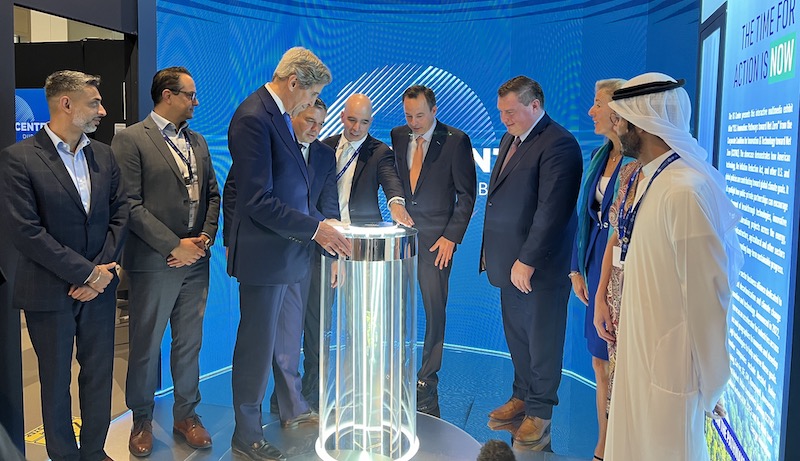
This year’s COP28 in Dubai, United Arab Emirates (UAE), was no different, as representatives from 130 governments pledged to triple the world’s renewable energy capacity by 2030, while more than 20 countries from four continents launched the Declaration to Triple Nuclear Energy by 2050 and committed to accelerate the adoption of other technologies like hydrogen as fuel and carbon capture and sequestration. The UAE and participating countries used the event to champion climate action, urge renewables adoption, and promote global financing solutions, among other initiatives. Over the past couple of weeks, GE has taken on a key role in projects regionally and globally and demonstrated its readiness to employ innovation and technology to help countries accelerate the energy transition and innovate a smarter, more efficient future of flight.
Global Solutions
As the saying goes, climate change is a global problem, and it needs global solutions. GE Vernova, whose installed base of technology helps generate approximately 30% of the world’s electricity, acknowledged this opportunity in Dubai by announcing that it would join the First Movers Coalition (FMC), a group of companies leveraging their purchasing power and global footprint to decarbonize the world’s heavy-emitting sectors.
By joining, GE Vernova made a voluntary commitment that at least 10% of all steel purchased will be near zero emissions by 2030. “GE Vernova is proud to join the First Movers Coalition as we focus on accelerating the path to more reliable, affordable, and sustainable energy,” said Scott Strazik, CEO of GE Vernova. “As we continue our work to electrify and decarbonize the world, the FMC’s initiative provides an important opportunity to succeed in product stewardship and energy at the same time.”
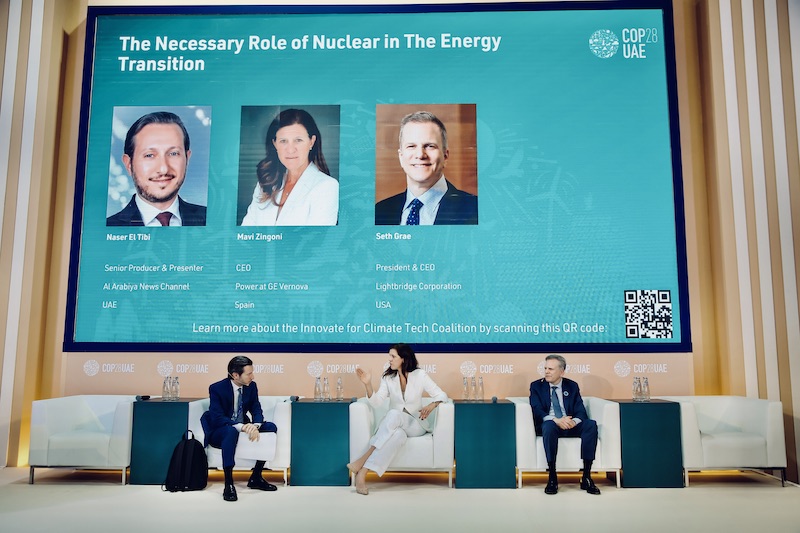
In a first for the U.S. Center at COP28, Strazik also unveiled the U.S. Innovation: Pathways Toward Net Zero exhibit along with John Kerry, U.S. special presidential envoy for climate. Presented by the Corporate Coalition for Innovation & Technology Toward Net Zero (CCITNZ), which includes GE and nine other industrial leaders, the interactive exhibit features the latest American innovation and technology, including how GE Vernova is helping to electrify and decarbonize the world and how GE Aerospace is inventing the future of flight.
Small Modular Nuclear Gains Momentum
Nuclear power is critical to decarbonizing the energy sector and achieving the net zero carbon emission goals of the Paris Climate Agreement. GE Vernova’s nuclear business, GE Hitachi Nuclear Energy, signed a memorandum of understanding (MoU) with the Emirates Nuclear Energy Corporation (ENEC) to identify investment and development opportunities in small modular reactor (SMR) technology. The MoU intends to explore opportunities for the deployment of GE Hitachi’s innovative BWRX-300 reactor plant design in the Middle East and Africa, which is in line with the growing global interest in harnessing smaller, more flexible, and economically viable nuclear solutions.
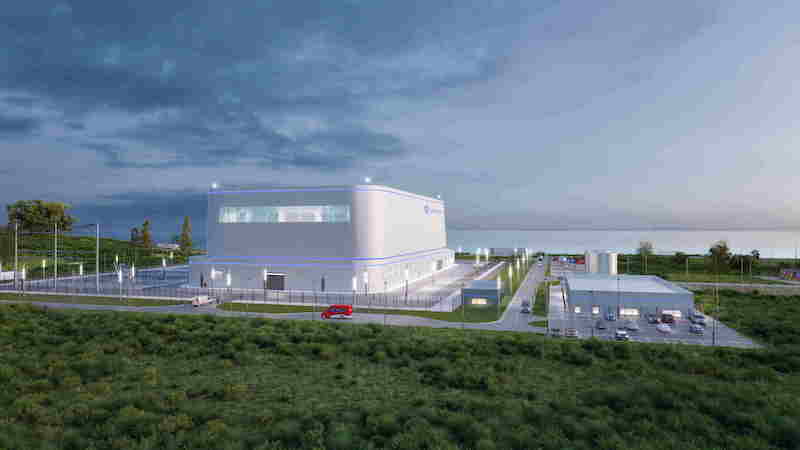
The MoU is part of the new ENEC ADVANCE program, which aims to expedite and centralize the UAE’s approach to deploying state-of-the-art nuclear technology. “It is a testament to our leading role in the future of clean energy in the region as we explore the integration of advanced nuclear technologies and the use of state-of-the-art SMRs around the world,” said Mohamed Ibrahim Al Hammadi, ENEC’s chief executive officer.
Stepping Up With SAF
GE Aerospace is also helping to accelerate a more sustainable future of flight. On the eve of COP28, Dubai-based Emirates became the first airline to operate an Airbus A380, the world’s largest passenger airliner, using 100% sustainable aviation fuel (SAF) in one of its engines. The jet used conventional jet fuel in three of its four Engine Alliance* GP7200 engines and 100% SAF in the fourth engine, marking another milestone in the industry’s growing momentum to bring standardization, certification, and adoption of 100% SAF closer to reality. Take a look at how GE Aerospace made progress to reduce emissions in 2023.
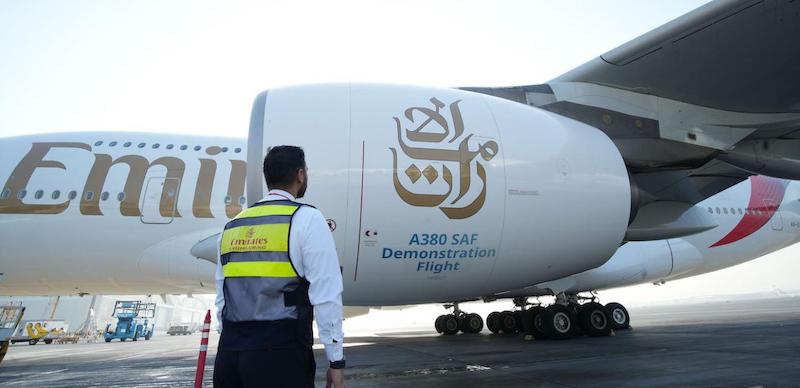
Supporting Korea’s Domestic Hydrogen Ecosystem
GE Vernova looks to engage globally on breakthrough decarbonization technology. To that end, together with SK E&S Co. Ltd., GE Vernova signed a multi-party MoU with Chungcheongnam Province, Air Liquide S.A., Santos Ltd., and Korea Midland Power Co. Ltd. to develop a large-scale low-carbon hydrogen value chain in South Korea, which will consist of a low-carbon hydrogen production plant, a hydrogen power plant, and a trans-boundary carbon storage site. As part of the collaboration, GE Vernova will endeavor to provide the technology for the hydrogen plant.
The signing was performed at a ceremony at the Korean pavilion at COP28 in Dubai, attended by Roger Martella, GE and GE Vernova chief sustainability officer. “GE Vernova and Korea share a proud commitment to innovation, and we look forward to partnering with leading companies in Korea to help achieve carbon neutrality goals by 2050,” said Martella.
Emphasis on Efficiency
During COP28, GE Vernova announced a collaboration with Alfanar Construction and the Saudi Electric Company (SEC) to transition a large fleet of its 7E turbines to run on natural gas instead of liquid fuels at the 3.5-gigawatt (GW) Power Plant 10 (PP10) in Riyadh, one of the largest power stations in the world, and help the country meet its carbon reduction goals.
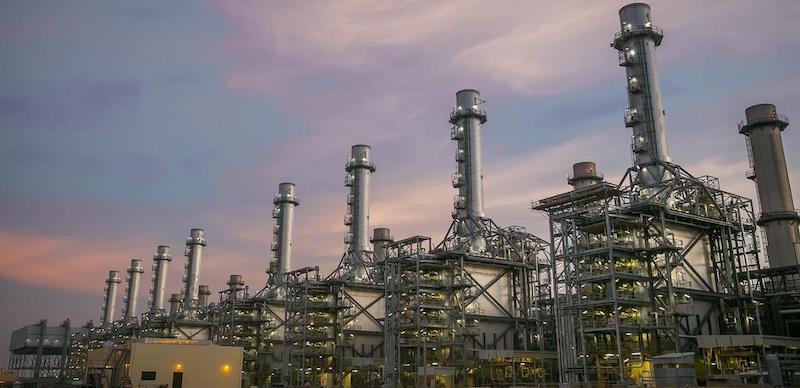
“Following this project’s completion, each gas turbine’s efficiency is expected to increase by up to 0.3% and to generate up to 1.7 million fewer tons of carbon dioxide (CO2) emissions per year for the same amount of power generated,” said Joseph Anis, president and CEO of GE Vernova’s Gas Power business in Europe, the Middle East, and Africa. In fact, the benefits are twofold: The efficiency gains will help to boost PP10’s actual power output by up to 4%.
GE Vernova is also assisting nearby Kuwait, which is seeking to generate 15% of its power from renewables by 2030, to reduce emissions and improve asset reliability, availability, and productivity. It signed a five-year agreement with TNB REMACO–Al Dhow, a Malaysian-Kuwaiti joint venture, to provide services to the gas turbines at the 878-megawatt (MW) Shuaiba North Power Station facility in Al Ahmadi, Kuwait, and help that nation to modernize its power generation infrastructure.

Promoting Sustainable Development
It’s estimated that the cost of achieving a global net zero energy transition by 2050 will be nearly $300 trillion, and GE Vernova is helping lead efforts to source and secure the capital required to do so. In Dubai, GE Vernova’s Financial Services business signed a MoU with the Islamic Corporation for the Insurance of Investment and Export Credit (ICIEC), which provides investment and export credit insurance for entities in member states. The MOU, which leverages ICIEC’s insurance and credit enhancement solutions alongside GE Vernova’s renewable energy expertise, will enable sustainable development and climate action across ICIEC’s 49 member states.
“This partnership reflects our dedication to fostering economic growth while adhering to the principles of Shariah and upholding the highest environmental and social standards,” said Oussama Kaissi, the chief executive of ICIEC.
“We’re thrilled to work with ICIEC on this exciting advancement toward funding and developing impactful energy transition projects in the region,” added Nomi Ahmad, CEO of GE Energy Financial Services, “and look forward to the progress this partnership can create, in line with GE Vernova’s mission to electrify and decarbonize the world.”
Digital Makes a Difference
GE Vernova’s Digital business spread the word at COP28 about new software solutions the company has developed that can help the industry work more constructively toward lowering CO2 emissions. For example, the CERius software solution employs artificial intelligence to gather more accurate emissions data, which can assist customers in reducing carbon emissions over time.
In a recent article in Oil & Gas Middle East, Linda Rae, general manager of power generation and oil and gas software at Digital, noted that “digital software is already making a difference across industry and the globe when it comes to reducing emissions as these technologies exist today. However, digital software adoption is not happening fast enough and at scale to move the emissions needle.” New software solutions like CERius, she said, “will help the energy sector, especially the hard-to-abate industries, identify where and when are the best opportunities to apply those abatement strategies and spend money most effectively.”
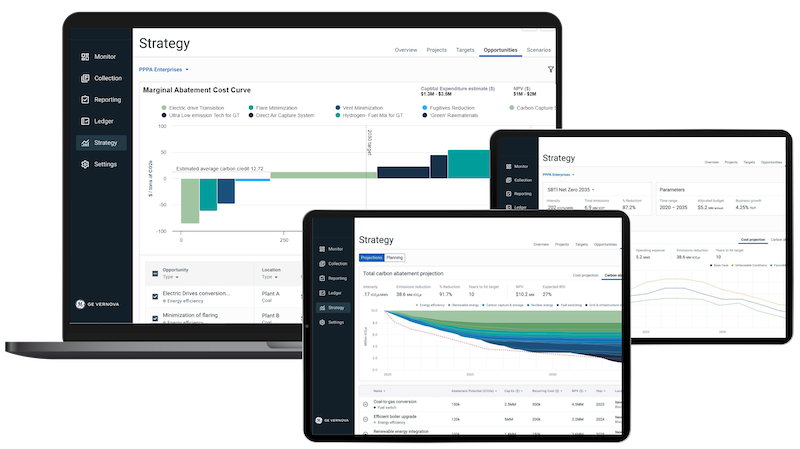
As GE prepares to launch GE Aerospace and GE Vernova as independent companies in the beginning of the second quarter, the company is advancing its commitment to sustainability and climate action, drawing on GE’s more than 130-year legacy of lifting up the quality of life for people around the world. By sharpening its focus on the specific missions of each business, GE is gaining more opportunity for GE Vernova to electrify and decarbonize the world and for GE Aerospace to invent the future of flight.
*The Engine Alliance is a 50-50 joint company between GE Aerospace and Pratt & Whitney





